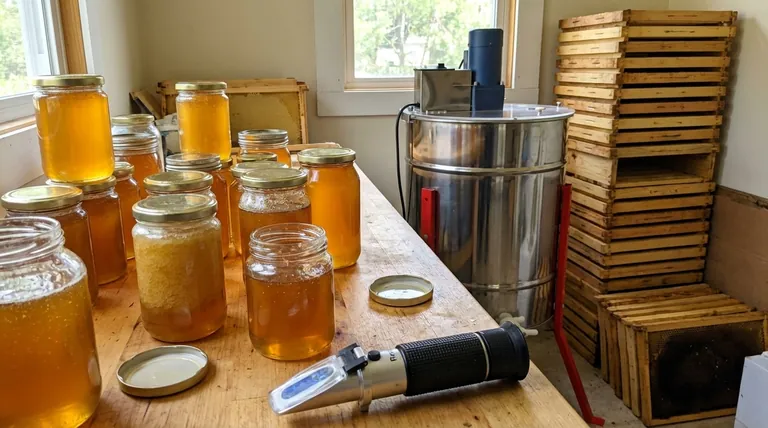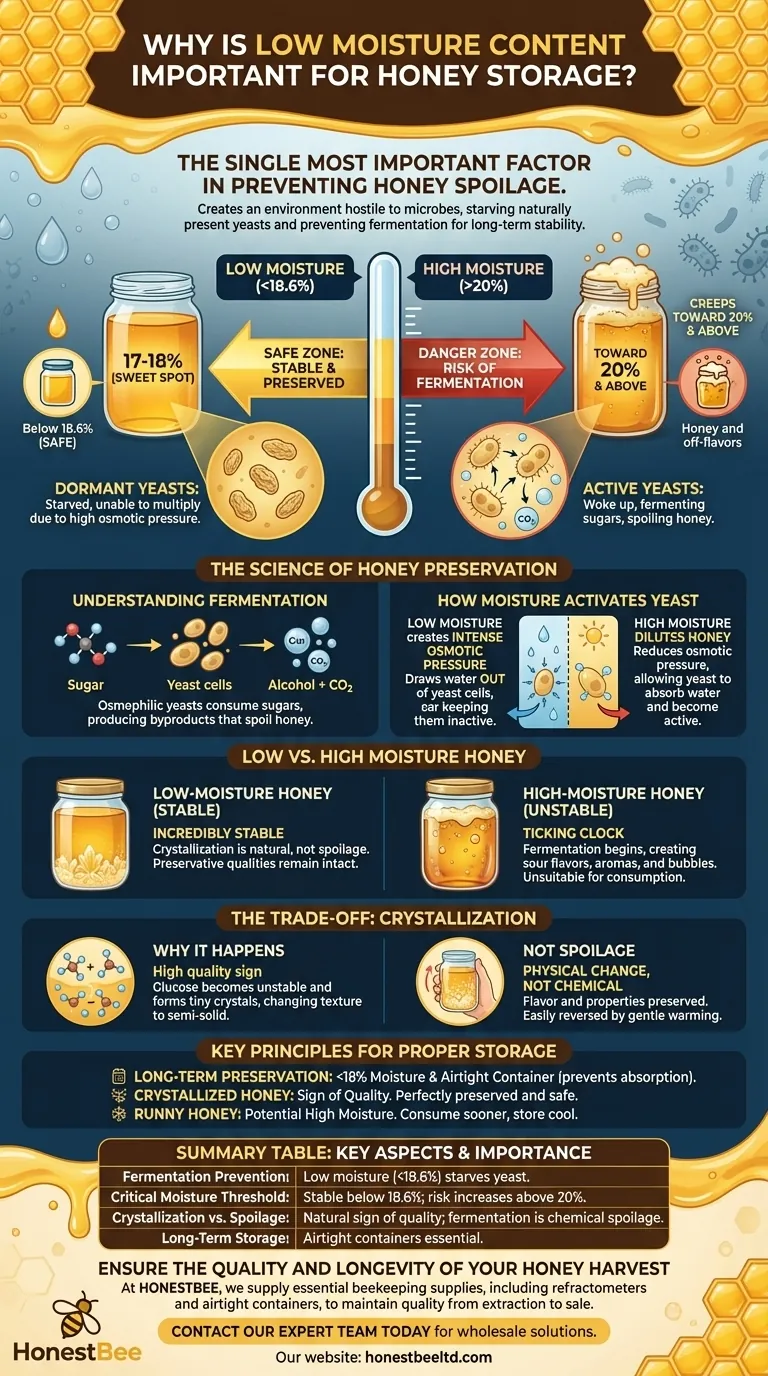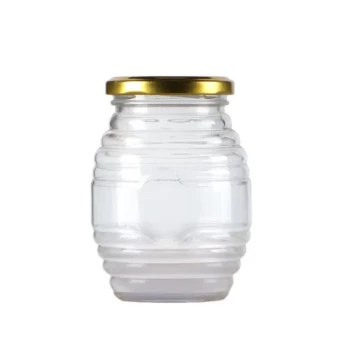To put it simply, low moisture content is the single most important factor in preventing honey from spoiling. It creates an environment so hostile to microbes that naturally present yeasts cannot multiply and trigger fermentation, ensuring the honey remains stable and preserved for long-term storage.
The core principle of honey preservation is controlling its water content. By keeping moisture below the critical threshold of around 18%, you effectively starve the yeasts that cause fermentation, guaranteeing the honey's remarkable shelf life.

The Science of Honey Preservation
Understanding Fermentation
All raw honey contains dormant, sugar-tolerant yeasts (osmophilic yeasts). These microscopic organisms are harmless and unnoticeable when inactive.
Fermentation is the process where these yeasts "wake up" and begin consuming the honey's natural sugars. As they metabolize the sugar, they produce byproducts like alcohol and carbon dioxide, which spoil the honey.
How Moisture Activates Yeast
Yeast, like all living organisms, requires water to thrive. The high sugar concentration and low water content of proper honey create intense osmotic pressure, which draws water out of the yeast cells and keeps them dormant.
When the moisture content rises above a certain point, typically around 20%, the honey becomes diluted. This reduces the osmotic pressure enough for the yeast cells to absorb water, become active, and begin the fermentation process.
The Critical Moisture Threshold
The ideal moisture content for honey is between 17% and 18%. This narrow range is the sweet spot that ensures maximum stability.
Honey with a moisture content below 18.6% is considered safe from fermentation. Once it creeps toward 20% and above, the risk of spoilage increases dramatically.
Low Moisture vs. High Moisture Honey
The Stability of Low-Moisture Honey
Honey with a low water content is incredibly stable. Even if it crystallizes, which is a natural process, the honey itself is not spoiled. The fundamental composition remains intact, and its preservative qualities are unchanged.
The Instability of High-Moisture Honey
Honey with excess moisture is a ticking clock. Fermentation will begin, creating sour or alcoholic off-flavors and aromas. The honey may appear bubbly or foamy as the yeast releases carbon dioxide, and it is no longer suitable for consumption or sale.
The Trade-off: Crystallization
Why Low Moisture Encourages Crystallization
Crystallization is often misunderstood as a sign of spoilage, but it's actually a hallmark of high-quality, low-moisture honey. In honey, glucose is less soluble in water than fructose.
When the water content is low, the solution is supersaturated with glucose. This makes the glucose unstable, causing it to separate from the water and form tiny crystals, which changes the honey's texture from liquid to semi-solid.
Crystallization Is Not Spoilage
It is critical to understand that crystallization is a physical change, not a chemical one. The honey's flavor and beneficial properties are preserved.
The process can be easily reversed by gently warming the honey, which will dissolve the glucose crystals back into the solution. This confirms the honey was never spoiled, merely changed in texture.
Key Principles for Proper Storage
- If your primary focus is long-term preservation: Ensure your honey has a moisture content below 18% and store it in a sealed, airtight container to prevent it from absorbing moisture from the air.
- If your honey crystallizes: Recognize this as a sign of low water content and high quality, not a defect. It is perfectly preserved and safe to eat.
- If you encounter honey that is runny or thin: This may indicate a higher moisture content, making it more susceptible to fermentation. Store it in a cool place and consume it sooner.
Ultimately, controlling moisture is the definitive factor in protecting the integrity and timeless quality of your honey.
Summary Table:
| Key Aspect | Why It Matters for Honey Storage |
|---|---|
| Fermentation Prevention | Low moisture (<18.6%) starves yeast, preventing spoilage and off-flavors. |
| Critical Moisture Threshold | Honey is stable below 18.6%; risk of fermentation increases dramatically above 20%. |
| Crystallization vs. Spoilage | Crystallization is a natural sign of quality; fermentation is chemical spoilage. |
| Long-Term Storage | Airtight containers are essential to prevent moisture absorption from the air. |
Ensure the Quality and Longevity of Your Honey Harvest
As a commercial beekeeper or distributor, protecting your product from spoilage is critical for profitability and reputation. The principles of proper moisture control are fundamental to your success.
At HONESTBEE, we supply the essential beekeeping supplies and equipment—including refractometers for precise moisture testing and airtight storage containers—that help commercial apiaries and distributors maintain honey quality from extraction to sale.
Contact our expert team today to discuss wholesale solutions tailored to your operation's scale and ensure every batch of honey meets the highest standards of stability and purity.
Visual Guide

Related Products
- electric honey extractor honey centrifuge 3 frame honey extractor stainless steel honey frame extractor
- HONESTBEE 3-Frame Manual Acrylic Honey Extractor
- 24 Frame Honey Extractor Commercial Radial Honey Frame Extraction Machine
- 8-Frame Electric Self-Reversing Honey Extractor Spinner for Commercial Honey Extraction Equipment
- Plastic Hand Crank 2 Frame Honey Extractor Low Price
People Also Ask
- What are the main processes involved in honey processing? From Hive to Jar, A Complete Guide
- What is the basic principle of the honey extractor? Harness Centrifugal Force for Efficient Harvesting
- How does an electric honey extractor work? Automate Your Harvest for Maximum Efficiency
- How long does honey take to extract? A Guide to Streamlining Your Harvest Process
- What happens to the frames after spinning in the extractor? A Guide to Sustainable Frame Management



















